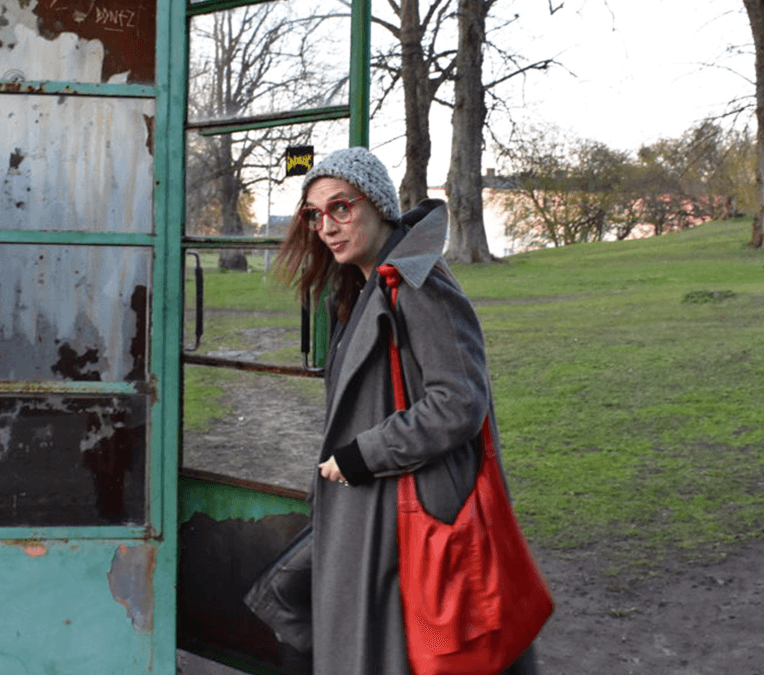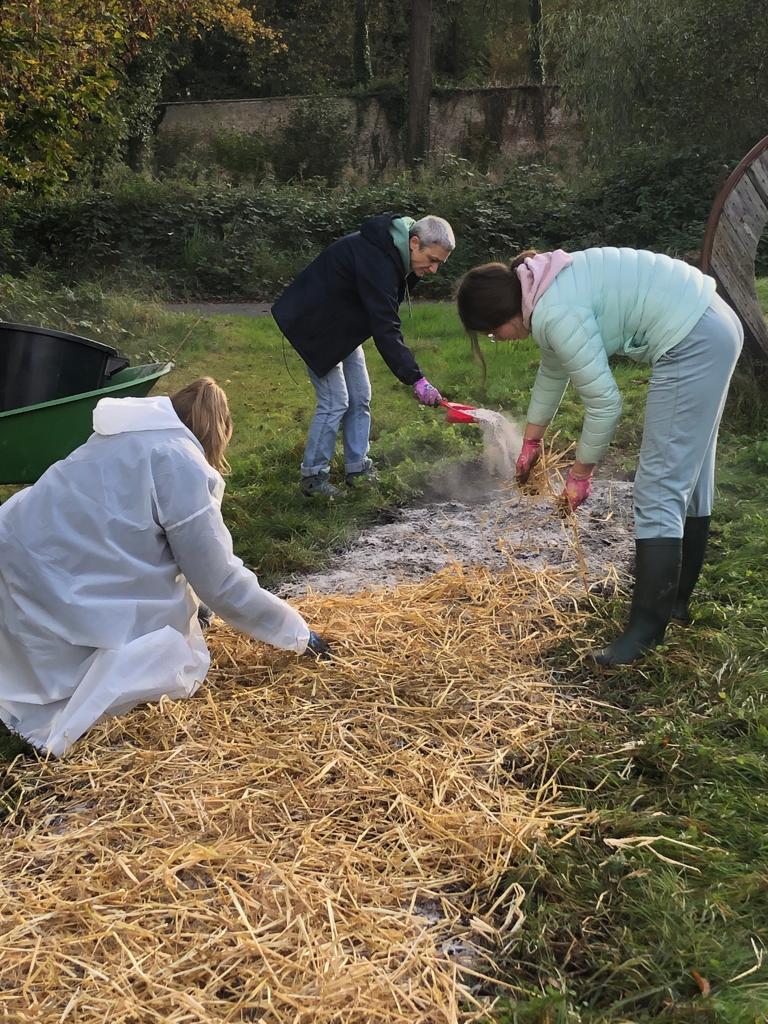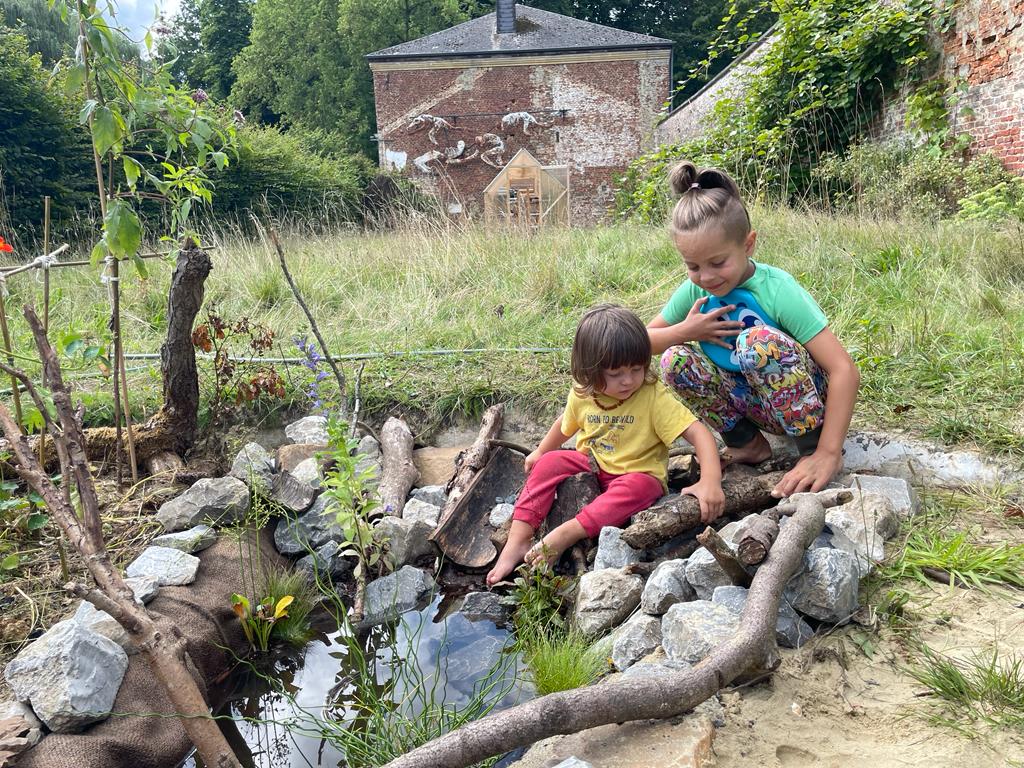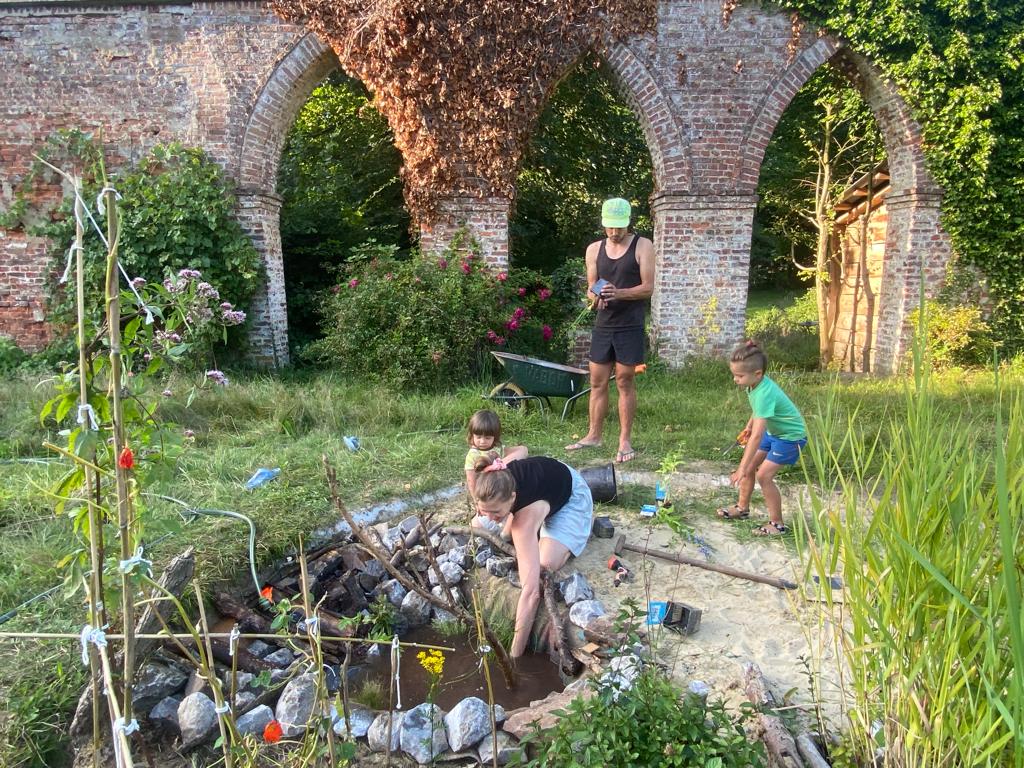Permaculture – Micro-tactics and a Lesson in Unlearning: Ivana Momčilović Dramaturge & Jelena Šaletić Agronomist
The innovative permaculture reconversion experience of the “Orangeries de Bierbais” park (Belgium), an English garden that contained monumental tropical greenhouses during the 19th century (1828).
After the intervention of brutalist architects in the 1970s, a few years back, Orangeries became a “third place”, experimental, self-managed, and self-learning center open to artists, researchers, and the wider public. In the heart of it, a “Laboratory of Radical Peace” by collective PhD In One Night and Fondation La Nacelle, connecting local voices to Kurds, Palestinians, Zapatistas, Congolese, high school agriculture students from Zrenjanin and all interested experimenters ready to leave seeds of future and participate in the reconfiguration of historical site…
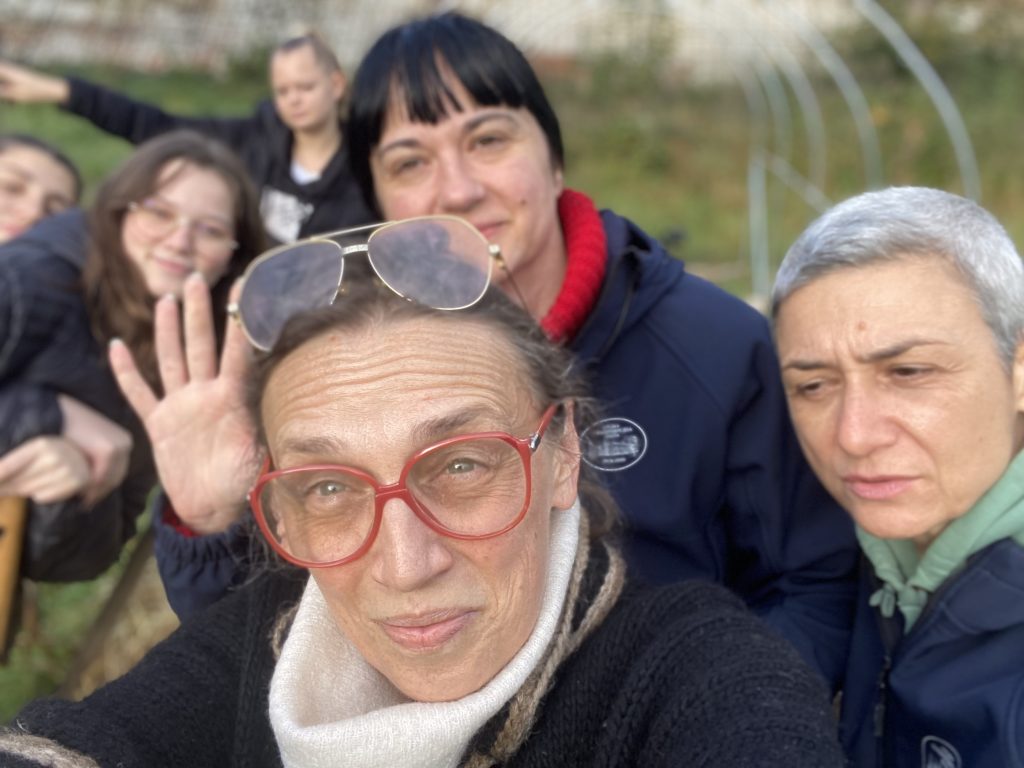
Permaculture is based on the cultivation of plant crops emerging from the principles of natural ecosystems, and these are methods that were used by ancient civilizations but were abandoned due to the impossibility of mass production. And that is where its greatest value is hidden, which, according to our interlocutors, the playwright Ivana Momčilović and the professor at the Agricultural School in Zrenjanin, Jelena Šaletić, represents a true micro tactic of survival and reorganization in a dehumanized society that is almost irreconcilable with the principles of nature and life.
From Ivana’s joining and conception of the self-organized art and research center Orangery Bierbais in Belgium, organized according to the principles of the “third space” and the Radical Peace Laboratory, this love for unfettered, but human-assisted nature, reached Professor Šaletić and her students in Secondary Agricultural School in Zrenjanin and through them began to “grow roots” on new generations.
At the upcoming Mikser Festival 2024 “Microtactics” from May 23-25 in Belgrade, Ivana will be the host of the program section that will provide insights into practical and theoretical knowledge about this self-organized initiative of a new connection between the urban and the rural, but also aesthetics and agriculture, as well as the broader political implications of this kind of “intimate activism” and the practice of self-training, through the “PhD in One Night” international platform for ethical education for everyone, as well as the relationship to cultural and historical heritage.

– The idea of introducing permaculture into the historic English garden from 1828, which probably had one of the oldest monumental greenhouses of tropical plants in Europe, came from my colleague and friend Martin van der Bellen, whose family owns the historic park and the Orangery buildings. Namely, Martin got acquainted with the principles of permaculture in Africa, where he lived for the last 20 years before coming to Europe. On a local farm in Benin, he was helping with the vegetable garden and that’s when he heard about the specific coexistence of all forms of life, which seemed to him salutary as a model of cohabitation of thought and practice in the current world. Interestingly, I met Martin in 1991, five kilometers from the Bierbais Orangery (Orangeries de Bierbais) in the student town of Louvain la Neuve, in the action “Yugoslavian Artists against the War” when he was the coordinator of a student festival where a few of us gathered in collective artistic actions and interventions of the future collective EI-Migrative art various Yugoslav artists (Sonja Savić, Kugla Glumiste and many others), which aimed to form some kind of free temporary territories. Thirty years later, we continue the action of free temporary territories that are for all of us, precisely in this park, which lead from private property to the common good, through the process of decolonization, permanent learning, self-education, experimentation, and the development of collective intelligence – Ivana starts.
Although her education and professional experience are deep in the arts and social sciences (research between dramaturgy and philosophy), she found a link between these disciplines and agriculture and how they mutually strengthen and nurture each other.
-Working for years on Jacques Rancière’s ideas of indisciplinarity, according to which the poetics of knowledge implies non-separation between different fields of knowledge, for about 15 years I have been participating in the launch and operation of the Ph.D. In One Night platform, an international platform for aesthetic education and experimentation for everyone, according to these principles. This platform starts from two hypotheses of Jacques Rancière:
- Indisciplinarity is “the quality or fact of including or relying on two or more branches of knowledge.” It is a way of crossing the boundaries of disciplines that maintains those boundaries. It affirms the idea that each discipline is defined by a specific competence – and, by the same token, specific incompetence – so that the multiplication of this knowledge reproduces a world of knowledge structured by a multitude of forms of exclusion based on a fundamental separation between those who know and those who do not know, those who think and they who do not think. Since this separation was precisely the “object” of my study, it is clear that I cannot use that method.
- The poetics of knowledge is therefore the practice of “indisciplined” thinking. It rejects the specialization of fields, objects methods, and assumptions along with the separation between two types of intelligence. It starts from the assumption of equality – Jacques Rancière, “Method of equality: politics and poetics”, Edition Yugoslavia, 2015.

For about 15 years, together with colleagues who are in our self-organized platform, we have been working on patenting and experimenting with new, alternative, interdisciplinary methods of sharing and exchanging knowledge, i.e. through art (sculpture, electro-sound installations, collages, dance) to learn and learn about other disciplines – mathematics, geometry, French, fiction, philosophy and much more. The experimental courses that we held mostly in Finland (high schools and universities, and Academy of Arts) and throughout Europe (primary schools, Academies of Arts, Universities), remote islands (Vis) as well as in migrant centers (literacy in French through contemporary dance and collage) have shown that such courses, which include knowledge as a comprehensive field and do not start from the separation of the field of knowledge, nor the separation between those who know and those who do not, as well as those who are capable and those who are not – give exceptional results in terms of self-confidence and emancipation of participants and experimenters, and the achieved results of the educational process – Ivana explains and adds that the core of these methods is self-education, permanent experimentation and the experience of learning as an artistic creation and research.
It is these hypotheses that start the adventure of permaculture and work on the land, and this is precisely the moment of connection between Ivanina’s Orangery and the Secondary Agricultural School in Zrenjanin and Professor Jelena Šaletić and her students.
-In our plans and programs, there is still a conventional way of production and everything we do, especially in the practical part, is the result of personal initiative. That’s how contact was established with Ivana from the Bierbais Orangery, and last year we (two professors and three students) visited her for seven days as part of the Erasmus Plus program and demonstrated our way of growing herbs in a part of their garden. That’s where we met the concept of permaculture. Immediately after our return, we prepared a smaller area based on the principles of permaculture – a combination of aesthetics and new methods of soil cultivation, so that this February we would do the same with a significantly larger area. It is new to us, and we are just getting to know its principles and application possibilities. But what’s fascinating about permaculture is that it’s not just applicable to gardening, it’s practically a way of life. Permaculture began to develop as a concern for the earth and nature, but today it encompasses all aspects of life. That’s why I keep telling my students that permaculture should be lived every day: wherever you can go on foot or by bike, collect rainwater, save old varieties of seeds, collect wild herbs, make a home composter, buy from local producers… Permaculture and organic production have many similarities, they were created on the same foundations and the goals are identical – a sustainable way of life – emphasizes Jelena.
Although this concept is very innovative for a secondary school in Serbia, Jelena has the support of the principal and her colleagues, and permaculture was introduced into the compulsory school curriculum at the suggestion of Professor Šaletić upon her return from Belgium. On the other hand, the means at her disposal are modest, and she believes that individual attempts will not enable the wider acceptance and application of these methods and the change of culture in gardening.
– Precisely because of this, the proposal was to include organic production in education plans and to create city gardens where teachers would educate citizens on ecological production, but there was no response. Without including this type of production in the mandatory plan and program of primary and secondary education, it will continue to remain on small scales, on individuals who cannot connect and educate and will be left to fend for themselves – warns professor Šaletić.
On the other hand, Ivana’s experience shows that this opportunity to constantly and informally learn from each other delights a large number of visitors as well as artists, researchers, and philosophers who stayed in the Orangery and that the opportunity to do something on the ground for the first time and participate in a common work fills them with pride and joy.

Students and professors from Zrenjanin with their hosts in Belgium 2023
– We patented the “Collective Garden of Guerrilla Knowledge” which is located in the former fountain of the historic greenhouse with orchids, after the mysterious disappearance of the greenhouse became a playground with sand and is now a place where everyone who wants to contribute with one “ray” of the garden to visiting their micro garden in common piece of land, and according to the principles of permaculture. The heteronomy of this garden and the fruits it produces is a great satisfaction for everyone who participated in the reconfiguration of this forgotten place, by bringing in new life that now gives new life – Ivana leads us through a process of experimentation and unlearning through which she says that even for her it will never be final, but she points out that this is precisely the principle by which self-organization or the intervention of a small group of individuals can revitalize any neglected city corner and make it beneficial for those who live there.
-Our last nomadic adventure of experimental courses started in 2020 the time of Covid through Guerrilla University, online sessions with Kurdish partners in Rojava University, in the temporary free territory inhabited by Kurds in the north of Syria. In cooperation with the students and professors of this self-organized university, we discovered their incredible action in “Green Braid” – planting four million trees in the middle of the war zone and environmental disasters. A wide range of actors are involved in this action: students, professors, pensioners, and children. By temporarily inhabiting our platform in the Bierbais Orangery, where we have been in residence for a longer period (now for three years), we had the honor of having representatives of the Kurdish organization “Green Braid” be our guests in Belgium and plant two olive trees of peace. We also hosted rebellious landless peasants from Mexico, the Zapatistas who have long been working according to the principles of permaculture, and who planted the ancient seed of the future – spelta. It is our way to continue to connect with this oasis of pleasure and peace of the Orangery, the key problems of this world, and the ancient techniques of working on the land which all have – permaculture – recycling of all organic resources with the aim of self-sustainability. Thus, we will soon host our dear guest artist from Gaza, Taysir Batniji, who, along with the work he will leave in the park, will participate in the work of the collective garden in parallel with the artistic intervention he will leave – announces Ivana.
The main principles of how permaculture is implemented in practice are revolutionary postulates, especially concerning what we are taught to consider a “healthy and well-kept” garden.
– “Chop and drop” and “no-dig” techniques. In this sense, both principles start from the assumption that everything in nature and society is connected and that everything cohabits. Therefore, the plants that are dried or the roots of the plants that have become wet are thrown back to where they were harvested from, they will serve as organic matter and with their fermentation will contribute to the better work of microorganisms in the layers below the roots of the plant. Also, this technique proposes the postulate of “not digging”, not going deep, but stacking organic layers in height and on the surface of the earth. In this way, all the organic matter that you never thought could become a new zone of life (dry leaves, ash, ground wood, straw, dry grass, dry pine needles, manure) will be found in one place. Instead of disturbing and destroying large amounts of micro-organisms hiding beneath the surface soil by digging, we are adding layers to the surface of the soil whose decomposition helps fertilize it. The whole process begins with an aesthetic act, drawing, sketching, and giving shape to pre-culture zones. After that, they move on to the action of a kind of “land art”, drawing and sculpting on the ground: the cardboard is cut according to the imagined forms, it is poured with water mixed with fermentation agents (we use a liquid with microorganisms – a mixture of bacteria, yeast, and mushrooms that break down the cardboard and support fermentation – it is possible to find recipes for the production of these agents as well), organic layers are applied to it and all of this mixed with a little soil forms the space of new life that will spring up. The constant covering of the ground with organic matter makes the permaculture zones aesthetically shaped units, and the organic matter also helps to keep the grass from covering the crop. So, everything is connected – with pleasure Ivana explains the process in detail.
Apart from this sculptural and artistic approach to agricultural techniques, permaculture is actually, says Ivana, a political practice based on the philosophical principles of the equality of nature and society and their alliance. This form of agriculture aims to draw inspiration from nature to develop synergistic farming systems, based on the diversity of crops, their resilience, and their natural productivity. The goal is to create a harmonious, resilient, productive, and sustainable environment, applicable in every place, starting with urban areas.
-The heart of the permaculture approach is based on three ethical pillars: Care for the earth. Caring for people (self and others). Work on abundance and redistribution of surpluses.
In addition, we can add principles:
- Working with nature instead of working against it.
- The problem is the solution.
- Work on the smallest change for the greatest effect.
- The only limits are the limits of our imagination.
- Everything that exists is connected to or impacts its environment.
In this sense and accordance with these postulates, our biggest challenge is precisely to give way to a kind of unlearning of the previous dogmas about how to grow a garden and a vegetable garden, and that is precisely permaculture, in the place of the historic English garden. In the model of the English garden and the famous dispute between two types of nature that man processes as an aesthetic model – the French and the English garden (this dispute between these two models was just discussed by Jacques Rancière in his book “Landscape Time” (2020), and the same intervention was held by our Green Guerrilla University, in Bierbais 2022. The English garden is considered more “suitable” because it represents wild nature and is closer to “natural nature”. The French type of garden is the type of Versailles spectacular geometric zones of cutting and shaping alleys and more reminiscent of the hegemony of man over But in his book, Rancière very precisely shows by going through the historical archives that the dispute about wild and artificial nature is a false dilemma because the English garden, with its waterfalls, lakes and all the attributes of “wild nature” was built by a man as well. As we are in one such garden, it is extremely important for us to start the new agricultural and horticultural cycle with really new foundations – true “wild nature” in which man will find his place but not restrain it – says Ivana and to our question, whether support for the wider application of permaculture would be necessary support from institutions, simply answers:
“Permaculture does not wait for institutions, it is an invitation to start immediately and now with the reconfiguration of the existing, it is exactly that “micro tactic” of our survival and action in today’s world.”
– By expanding the activity of experimentation, the zones of gardens and vegetable gardens will be multiplied “in a new way” and thus a counter-balance to the existing agendas and macro-plans that have long since begun to surpass us will be created. Permaculture is precisely the possibility not to sit idly by, to connect imagination with action, and to start now and here in this unique union of nature and society or as the proletarian revolution called it – “into an alliance of workers, peasants, and honest intelligentsia” – inspirited and with a smile, Ivana claims.
Apart from the social implications, getting your hands dirty in the soil, according to numerous studies, improves our mental health and resistance to stress. To this comment, Ivana replies briskly.
– I work on the ground without gloves, that feeling really cannot be compared to any other. The practice of “dirty hands” is definitely connected with active pedagogy, with pedagogues of the “school of experience” and “hands-on learning”, of which John Dewey (1859-1952) and William Morris (1834-1896) should definitely be mentioned. In the Orangery, as I mentioned, we are constantly faced with the joy of philosophers and other academic researchers who have never buried their hands in the ground, who feel great satisfaction after an experience in which, after the initial fear and blockage, they begin to experiment themselves – says Ivana for end and adds:
– We learn every day, constantly, and one anecdote that may be able to connect all of what we talked about is the fact that I am practicing the method of the “teacher who does not know” (see the book of the same name by Jacques Rancière translated by Leonardo Kovačević), that is, the method by which we apply that “everyone knows something and adds what he learns”, in the process of collective emancipation and the sum of individual equal bits of intelligence (also Jacques Rancière’s axiom that “intelligence is equal”) in the constellation called collective intelligence, in a non-hierarchical process of knowledge exchange in which everyone learns from someone something, I managed to convey my knowledge from permaculture to the professors and students of the Zrenjanin High School of Agriculture who were our guests within the Erasmus Plus program, and they managed to include their knowledge now in the regular school program and practice. This video testifies to that. It’s a really nice ending story that inspires hope that It’s a really nice ending story that inspires hope about the knowledge that is transmitted and created again and again singularly without being just a dull mass to be repeated. I learned a lot from the artist and wizard of the vegetable garden and gardens Laura Malonne, who, together with Hadrien Brichard who was with us on his voluntary service for 6 months as a gardener, dreamed up and constituted the forum of our vegetable garden, which for me is a truly functional land art. I am extremely grateful to them for the foundation on which we are all adding our layers now – concludes Ivana Momčilović.
The Pioneers of Zrenjanin
The secondary agricultural school in Zrenjanin has four educational profiles, it has a farm for training veterinary students and 100 ha of arable land for the profiles of agricultural technician, horticulture technician, florist-gardener, and operator of agricultural machinery. According to Professor Jelena Šaletić, the educational profiles of florist-gardeners and horticulture technicians did not have adequate spaces for practical teaching, which is why exactly 10 years ago, she created an eco-garden in a neglected area within the school.
– Today we call it the Bio Garden, and it consists of three greenhouses and outdoor areas where we organically grow vegetables, herbs medicinal plants, and flower species that are also edible. As part of the Bio garden, there is also a Bio workshop where we make macerates, dried vegetables, scented bags, seasoning salt, and aromatic (medical) pillows from the fruits of the garden. In the garden, we do not use chemicals, there is no plastic, we make compost, we have vermicompost and we make protective products with which we protect our plants in the garden, such as “fire spray” from hot peppers – reveals the professor and adds that all the students, as well as her colleagues, enjoy spending as much time as possible in this garden.
The Gardening Revolution
A small historical trivia: in 1790, Immanuel Kant defined the art of gardens as the “[art] of beautiful arrangement” of the products of nature in the “Critique of the Pure Mind”. Others before him had already expressed this idea, especially the Englishman Thomas Whiteley, 20 years earlier, in his work entitled “Observations on Modern Gardening”, which gave the following definition to the art of gardens: “The art of reaching the objects of nature in the most perfect way “. Kant distinguished two forms of art – mechanical art and free art and classified the art of gardens precisely in the second category. The main consequence of such a choice is that garden art is devoid of any utilitarian function. The creation of gardens within the liberal arts caused consternation among thinkers. According to the fruitful thesis of Jacques Rancière, Kant, by integrating the art of gardens into the fine arts, carried out a real “revolution” in terms of what we call nature, and thus freedom. Philosopher Jacques Rancière in his work, “The Time of the Landscape, at the beginning of the Aesthetic Revolution” offers a historical walk through these European regions of the 18th and 19th centuries, especially in the representation of landscapes through painting. How can we present landscapes where we are not physically present since they are still forbidden to us (private properties)? The author is interested in the short period when garden art was part of fine art. Indeed, in 1790, at the height of the French Revolution, the German philosopher of the Enlightenment, Immanuel Kant, brought the art of the garden and garden into the order of fine art, although until then it was, as could be expected, a part of architecture. A very interesting philosophical turn by which, by entering art, nature itself could become an artist.
The innovative experience of Orangeries de Bierbais continues. It is open to welcome volunteers, gardeners, horticulturists, artists, researchers, and varied talents necessary to reflect Orangeries de Bierbais, a place of experimentation and freedom, as facilitators of better and more egalitarian and emancipatory cohabitation between nature, aesthetics, and society.
The entire team of Orangeries de Bierbais thanks Jean Cedric van der Belen, the visionary, mécène and generous supporter who makes actually possible that Orangeries de Bierbais, from a family place, following paths of his father’s visions, become a “third place” open to all.
Contact:
Martin van der Belen
Ivana Momčilović
A. Malušev

